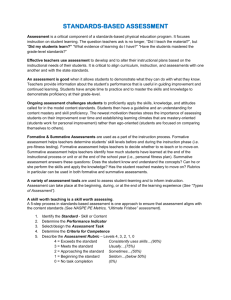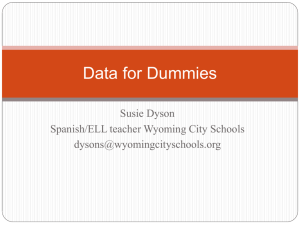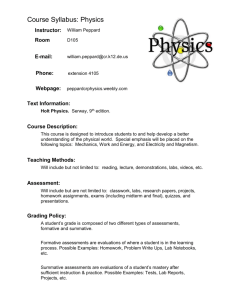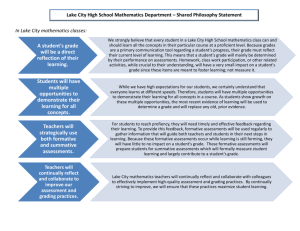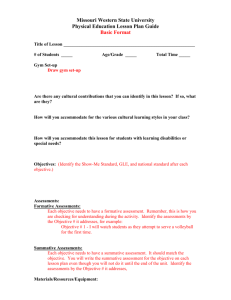FormativeAssessment2015 - the Biology Scholars Program Wiki
advertisement
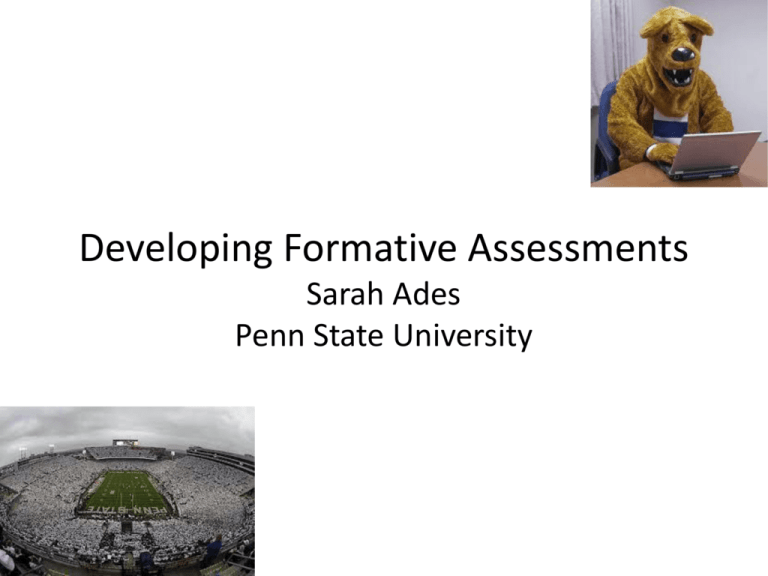
Developing Formative Assessments Sarah Ades Penn State University workshop learning objectives (outcomes): At the end of this workshop scholars will be able to: • Describe the role of formative assessment in learning. • Explain why assessments should be aligned to learning objectives and outcomes. • Evaluate different types of assessment activities to find those that are aligned best with the learner’s abilities and level of understanding to be assessed. • Develop aligned assessment activities to provide evidence of learning to both the instructor and learner. I am a junior majoring in biology. I usually get A’s in my courses; only a few B’s so far in college. I totally breezed through high school. It was so easy. I’m think that I might go to graduate school or medical school. This semester, I enrolled in introductory microbiology. I approach this class like most others—I attend lecture (have only missed two this semester!), read the textbook (usually before class, if I have time), and turn in the homework if it’s going to be graded. Prof. Lopez is great; he’s really well organized and follows the book closely. The homework has been helpful for learning the terms and information. The first midterm exam in this course was NOT what I expected. None of the questions were multiple choice. Instead, we had to write out short (and sometimes LONG) answers. I barely finished it in the 2-hour exam period. Plus, three of the questions tested us on things we never learned and skipped stuff we had covered in class. For example, we learned about a specific example of the lac operon in class last week. I worked really hard to memorize all the important steps in the process, and then it wasn’t even on the test. But there was this question about asking us to “describe a strategy that bacteria use to regulate gene expression and explain why such a strategy might have been selected for over time.” How am I supposed to know about that? I got a 72% on that test. What a crock! What went wrong? Handelsman, Miller & Pfund (2007) Scientific Teaching go to: b.socrative.com enter code: GX2MXSME link Instruction without goals…. Ready? Fire! Aim. aligned course What knowledge/skills do your students already have? What misconceptions do your students have ? Why are the students taking the course? change throughout course What experiences do your students bring to the course? ©2010 Michael Palmer Assessment What is assessment? A method to determine whether of not students learned (or accomplished) the learning objective. Evaluate and determine if the students are learning what they are supposed to learn. Measuring student learning. Assessment is how we monitor student's ability to learn. No real idea to be honest. A method or means of measuring learning. A way of determining what students actually understand and at what level they understand. To find out if what you think you are teaching them is what they are learning. Assessment is a process of measuring how effectively a course or program accomplishes its goals. A tool that is used to measure how well students have met the learning goals the educator has defined. It can also provide information to the educator about the effectiveness of their teaching methods. Tools used to measure student understanding and inform teaching practices. A way of evaluating effectiveness of teaching and learning. Just in Time Student-focused Teacher-focused Other Assessment What is role of assessment in teaching and learning? It gives instructors a way to monitor student learning. Helps us to understand where the problem is and figure out how to improve teaching and learning. To assure that students are learning what we intend them to be learning in the course. Assessment is used to plan, implement, and modify courses. It is how I know that students have learned a concept or idea. Not only how they have learned but at what level they are learning it. To gauge student learning for give formative feedback to help students in the learning process or to determine final learning gains using a summative instrument. If done correctly it should guide teaching and learning both. To find out if you are being successful in your teaching, and to show the student where their misconceptions are. Teaching strategies can be modified based on the results of assessment to improve learning outcomes. A consistent and defined way of improve teaching (iterative process of assessment, adaptation of practices, repeat). Assessment should be aligned with learning outcomes and should help us identify whether or not we've taught the materials effectively. It should include lots of low-stakes practice (formative assessment) and culminate in summative assessment(s). In the formative form it is to inform teaching and learning. What do I (my students) know and what do we need to work on. In the summative form it informs instructors and students about level of knowledge. Just in Time Student-focused Teacher-focused Other Assessment? Assessment a way of providing students and teachers with information regarding students' progress towards achieving the learning objectives. Evidence. The role of assessment in teaching and learning is to provide feedback to both the teacher and the student. It allows teachers to tell whether their teaching methods have been effective or whether they need to re-teach a particular concept. On the other hand, it allows students to identify misconceptions and gaps relating to the new content being learned. It also allows students to identify if they are studying effectively. Lets student interact with the material and practice skills Why do we assess / question? •Gather evidence on student learning (evaluation) •Improve a course Guide improvements •Improve our teaching •Improve society (?) •Get feedback on student understanding Guide teaching •Elicit misconceptions •Guide your own instructional decisions •Make expectations clear to students Guide students •Provide feedback to students •Give students an opportunity to gauge their progress •Help guide student studying and learning behavior assessments Learner learning objectives (outcomes) • • • instructional activtiies What evidence can show that students have achieved the desired results? What assessment tasks and other evidence will anchor our curricular units and thus guide our instruction? What should we look for, to determine the extent of student understanding? Wiggins and McTighe (2013) Understanding by Design Novice to Expert • According to Donald Rumsfeld: “There are known knowns. There are things we know that we know. There are known unknowns. That is to say, there are things that we now know we don't know. But there are also unknown unknowns. There are things we do not know we don't know.” conscious unknowing: know that you don’t know unconscious unknowing: don’t know what you don’t know conscious knowing: know how you know what you know unconscious knowing: don’t know how you know what you know Learner Novice • Content: isolated pieces of information to be memorized. • Handed down by an authority. Unrelated to world. • Problem solving: pattern matching to memorized recipes. Expert • Content: coherent structure of concepts. • Describes nature, established by experiment. • Prob. Solving: Systematic conceptbased strategies. Widely applicable. GOAL: use assessments to guide learning, build skills, and measure progression from novice to expert Ambrose 2010 How Learning Works http://www.cwsei.ubc.ca/resources/tools.htm formative • Adjective – of and relating to a person’s development • of and relating to a pedevelopment • Synonyms – Developmental – Growing – Malleable – Impressible – Determining – Influential • Purpose – “brief, low-stakes activities that students do in order to give both themselves and the teacher feedback about their level of understanding.” Stephen Chew in Chronicle of Higher Education summative • Adjective – of and relating to a summation • of and relating to a pedevelopment • Synonyms – Additive – Cumulative • Purpose – higher-stakes activities that are “cumulative in nature and is utilized to determine whether students have met the goals or student learning outcomes at the end of a course, unit, or program.” what types of activities can you use for formative assessments? http://padlet.com/sea10/formative what types of activities can you use for formative assessments? • • • • • • • • • • • • One minute paper Muddiest point Clicker questions- ConcepTest Empty Outlines One sentence summary Productive Study-Time Logs Misconception/Presumption Check Compare/contrast Concept maps Concept sketches Examine lab notebooks Course discussion board/blogging see also engaugements file on wiki Designing Aligned Assessments Endpoint: learning objectives and outcomes – summative assessments what students will know upon completion of this course/unit/class Roadmap: formative assessments and learning activities how students will reach goal - What gear is needed? - What are the intermediate steps along the way? - How will instructor and students know they are making progress? Starting point: prior knowledge and misconceptions what students know Where’s the start? Assessing prior knowledge, gaps in knowledge, and misconceptions Multiple Choice Quiz: • include common misconceptions as options • use both information retrieval and application questions Concept maps: • get an overview of what key ideas students know and how they think ideas are connected. ? Brainstorm: • ask leading question or pose a scenario, have students generate answers Self-assessment: • How familiar are you with ___? a) never heard of it. b) heard of it but don’t remember much. c) know what it is and can explain what it does. d) know what it is, when and how to use it. Remember: • Recall does not mean students can apply. • Look for misconceptions as well as concepts. • What is missing can be as informative as what is reported. traditional approach to teaching – Prof. Lopez you’ve read the book and sat through the lectures now you’re the expert ready, set, go!! developing understanding through formative assessments - add some steps along the way practice, practice, practice (reinforcement) increase complexity over time (scaffolding) To develop mastery, students must acquire component skills and knowledge, practice integrating them, and know when to apply them. mastery know when and how to apply skills and knowledge practice skills and using knowledge acquire component skills and knowledge Ambrose 2010 How Learning Works Jigsaw activity• Formative assessments Dr. Lopez could have used in his class addressing the following course level learning objective. Learning Objective: students will understand that bacteria are able to sense the environment around them and integrate that information to alter gene expression. Course Snap Shot Micrb202: Introductory Microbiology Laboratory (IQB) 3 sections, up to 36 students per section 2nd semester freshmen – first bio lab class taught by a faculty member with 2 learning assistants Wed/Fri 2 hours Inquiry-Based Intro Micro Lab Goal(s) By the end of this course • you will have a strong foundation in scientific inquiry and be prepared to apply these skills in future science courses. • you will be able to evaluate issues in “real-life” making you a life-long educated consumer of science • you will have the technical skills and fundamental concepts to address important questions confronting microbiologists in a variety of professions from medicine to environmental microbiology. contrasting lab approaches Inquiry Based basics provided, students seek additional information as needed array of materials provided students decide what to use Traditional background information materials protocols provided used to address scientific question student-directed students told what materials to use protocols provided techniques experimental design driven by scientific question open-ended generally all provided focal point of experiment teacher-directed, step-bystep instructions driven by technique outcomes known in advance active role as researchers role of students passive role following directions help students formulate experiments role of teacher tell students what to do learning objectives/outcomes Students will be able to: formulate a clear question develop a testable hypothesis plan an experiment evaluate and synthesize data communicate findings scientific method IQB approach experimental techniques Utilize: sterile technique key microbiological methods laboratory safety concepts of microbiology Discuss: microbial evolution environmental influence on microbes microbial interactions identify an unknown microbe Course Design • seven modules • lab guides - background, experimental challenge, key questions, relevant protocols - online quiz on major concepts taken before each module starts • design experiment - hypothesis, predictions, controls - brainstorming, group problem solving, peer and instructor review • perform experiment • evaluate data and draw conclusions - discuss with peers and instructors - compare results with other groups • keep lab notebook • make classroom a scientific community - discuss have periodic class mini-conferences • communicate findings - written lab report or oral presentation Experiment 3: Bacterial Behavior- Motility and Chemotaxis One of the distinguishing characteristics of animals is their ability to move in response to stimuli that originate from within their own bodies or from the outside world. Many of us are attracted to the smell of fresh-baked chocolate chip cookies and repelled by the aroma of a recently antagonized skunk. An animal moving rapidly toward an object it recognizes as food or fleeing a harmful chemical are examples from the repertoire of responses known as animal behavior. Even the simplest and smallest animals exhibit behaviors within their own sensory capabilities… Resources You can find basic information about flagella and chemotaxis in any microbiology textbook. Online resource with an overview of bacterial motility, flagella, and taxis: http://textbookofbacteriology.net/structure_2.html Key concept Bacteria behave in response to stimuli. Challenge We will use two different assays to determine if your pets are motile and chemotactic . We will also provide you with a plate of swimming E. coli and an assay to determine if a substance is an attractant or a repellent. Develop a hypothesis about E. coli’s responses to different compounds- we will provide you with some sugars and amino acids. You are also welcome to bring in other substances that you would like to test. Key Questions • What advantages does chemotaxis provide for a bacterium? • High concentrations of repellents increase the tumbling time of E. coli. How does this help the bacteria move away from the repellent? • Different bacteria chemotax towards different chemicals. Why might this be? • Some bacteria are not motile. What factors in their environment might allow them to flourish without selfpropelled motility? • Penicillium notatum is not motile. However, it spreads over the surface of a petri dish and can even spread from one piece of bread to another. How might either of these behaviors occur in the absence of self-propelled motility? course modules: reinforcement and scaffolding techniques motility assays simple microscopy motility assays bread, mold, and bacterial motility the environment and chemotaxis antibiotic resistance measurements antibiotic resistance measurements count bacteria purification of bacteria count viruses purification of bacteria/viruses microscopy microscopy pet microbe purification of isolate mutants bacteria/fungi microscopy count viruses pathogenesis random vs. adaptive mutation microbial fuel cell bioenergy skin microbiome environmental microbial host-pathogen microbial host-pathogen host-pathogen influences on interactions metabolism interactions metabolism interactions environmental microbial behaviorenvironmental identification of environmental environmental evolution influences on influences on microbiology microbiology unknown microbial growth microbial growth identification of identification of unknown unknown concepts host-pathogen interactions evolution complex selective and differential growth media Week 1 activity Objective: Students will begin to design experiment. 2 in class Sa/SuMon Tu Wed Th reading: basic micro concepts out of class 1 P. acnes/ph age Day 1 intro mini-lecture -background micro -exp to design - overview of procedure Fri Pre-class • skin microbiometextbook • Ted Talk podcast • pop. press article about P. acnes/phage 3 Mini-Lecture • skin microbiome • sebaceous gland • overview of unit • start thinking abt experiments to design • overview of procedures Objective: Students will grasp basic concepts of microbiome. Students will be familiar with overview of P. acnes and that there are phage that infect P. acnes assessment 1 2 3 preclass online quiz on readings basic knowledge think-pair-sharebrainstorm • list 3 factors that could influence antibiotic resistance of P. acnes Analyze Data Table on host range of P. acnes & phage • describe, interpret, apply • students explain what they might find activity Week 2 Objectives: Students will understand (how & why) procedures to be followed. Students will make connections to previous units. Students will understand the experimental strategy for purification of bacteriophage (Day 2). Pre-class • lab manual isolation steps notebook check Sa/SuMon Tu Wed Th out of class reading: lab manual reading: lab manual 1 Pre-class • lab manual phage purification Day 3 phage purification in class 2 notebook check Fri 1 Starter activityworksheet/flowchart Lab work preclass online quiz • purpose of main steps • sterile technique knowledge level notebook check Lab work 3 Day 2 Initial Isolation assessment 2 3 preclass online quiz • purpose of each step in phage purif. • i.d. of phage- plaque and capsid morph. knowledge/apply level Fill-in worksheet/flowchart do as teams - go over as class • why purify phage? • 2nd approach to get phage notebook check phage morphology Plaques? yes Purify! how? why? no Find those phage! how? Motivational methods: • Relate experiments to real world • Give students ownership of experiments • Treat students like scientists Formative assessments: • Pre-class quizzes (3 tries) • In class activities - design experiments, analyze data (own and from literature) • Notebook checks • Informal questions while circulating in class • Students can repeat some activities until they master them Summative assessments: • Lab reports (graded by rubric), rewriting allowed • Key questions – apply learning • No lab practicums – must master methods to identify and keep pet alive • Oral reports Does it work? • • • • • informal observations students get microscopes themselves to examine a sample students ask for materials for controls students discuss amongst themselves experimental design and results lab notebook checks show learning - improved hypotheses, controls self-reporting on SRTEs - ...involved thought and understanding. It was very helpful having the instructors come around and asking questions to be sure we - - • understood why and what we were doing not just to make sure we followed a procedure correctly. This course built on the material we learned in the beginning and continued to build on it, which personally helped me retain the information more than just about every course I have ever taken. The student query aspect of the course allowed me to learn that most that I possibly could have from MICRO 202. I really enjoyed asking my own questions for each experiment and feeling as though I had autonomy to set up the experiment as I saw fit to answer my questions. I believe that the set-up of this course allowed me to become a more confident science student and that I now have more of a sense of how to work in lab setting--it is now common sense to me to start with a hypothesis, to figure out what controls to set up to make sure that I can distinguish true results from inconclusive data...I don''t think I could have done that nearly as well without this course. applications from departmental majors for independent research - 60% of IQB section, 17% of all other 11 sections Designing Aligned Assessments 2. Content Identify components of concept. How are concepts integrated? How are concepts applied? 1. Student How are concepts used in real world? prior knowledge misconceptions 3. Deliverable Choose learning activity and concept/skill to be assessed. Decide level of learning to assess. Ensure assessment is appropriate for desired learning outcome. Ensure assessment will give desired evidence of learning. skills Consider how assessment will be evaluated. Learning objectives Your turn • Develop formative assessment aligned to your learning objective/outcome. • Pair with another scholar to share your assessments • Give feedback! Alignment Grid Learning Objective Taxonomy Level/Categor y Formative Assessments Summative Assessment The most important method of education . . . always has consisted of that in which the pupil was urged to actual performance. —Albert Einstein, Ideas and Opinions, 1954/1982, p. 60 https://www.flickr.com/photos/gforsythe/8204963410/sizes/z/in/set-72157626965187420/ References • Connecting Learning Goals and Assessments Workshop by Stephanie Chasteen (CU-SEI), 2011 http://www.cwsei.ubc.ca/resources/workshops.htm • Assessment strategies, Assessments ASM 2013_Obom_6.13.13.pptx Biology Scholars 2013 Assessment Residency • Ambrose, S. et al. How Learning Works, 2010, Jossey-Bass a Wiley Imprint, San Francisco • Handelsman, J. et al. Scientific Teaching, 2007, WH Freeman and Company, New York • Carl Wieman Science Education Initiative at UBC http://www.cwsei.ubc.ca/resources/index.html • Wiggins and McTighe, 2013, Understanding by Design Expanded 2nd Edition, ASCD

